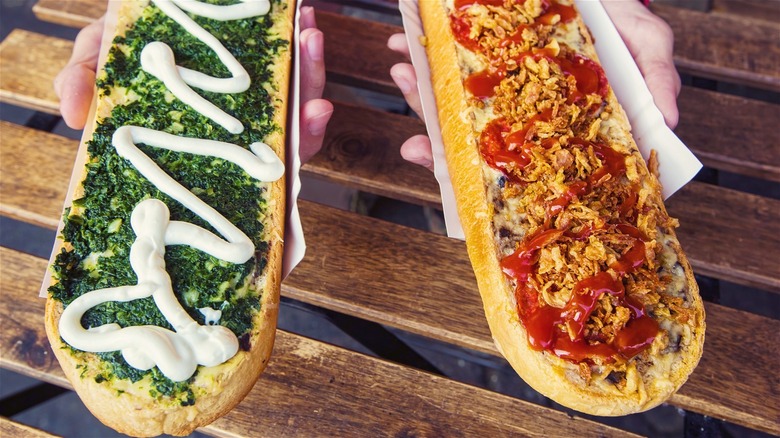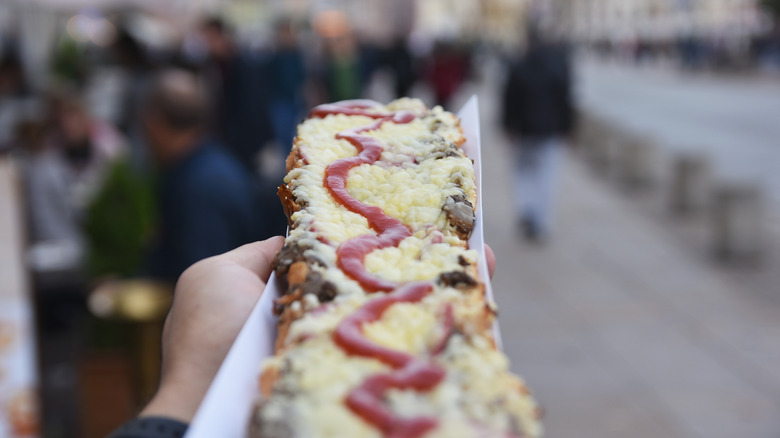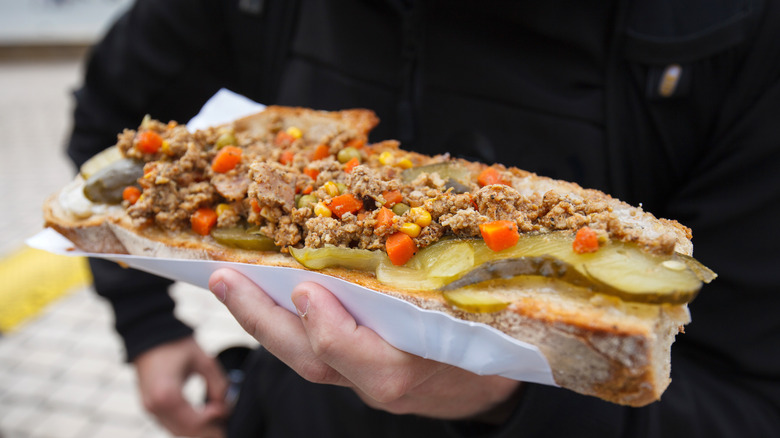Zapiekanka: The Open-Faced Sandwich With Polish Origins
Street foods the world over tend to have one thing in common -– they are often seen as a godsend by late-night drinkers staggering home from a hard night of partying. Turkey has its dolmas, Germany its currywurst and kebabs, and Thailand its steamed bao buns, but in Poland, they're all about the zapiekanka. This open-faced sandwich (since who's got the coordination to handle a top slice at oh-drunk-thirty?) is sometimes called "Polish pizza" and, in fact, some Americans may note a certain similarity to Stouffer's famous French bread pizza recipe. The main difference, however, lies in the fact that instead of pizza sauce, the tomato-based condiment typically used on a zapiekanka is ketchup.
The zapiekanka, while beloved by many Poles (sober ones included), hasn't always had the best reputation with traveling gourmets. While Andrew Zimmern did cover it in a "Bizarre Foods" episode, he kind of damned it with faint praise by saying it "comes from the timeless Polish principle of making a lot from a little." A Washington Post reviewer was even more scathing, calling it a "poor relative" of pizza and admitting it was something they only ate out of desperation back in the late '80s (and apparently never bothered to revisit on subsequent trips to Poland). Naysayers notwithstanding, zapiekanka vendors continue to thrive to this day.
History of the zapiekanka
As is the case with many street foods, we don't have a specific name or date to attach to the birth of the zapiekanka. What we do have, though, is a decade -– the '70s –- as well as a precipitating event. The secretary of the Polish United Workers' Party at the time, a man named Edward Gierek, arranged to have French-style baguettes produced in Poland where they subsequently became the base for a cheap and filling sandwich topped with whatever was to hand. Back in those days of still-struggling socialism, this mostly seemed to be mushrooms. Mushroom sandwiches actually seem to predate the introduction of baguettes, however, as a bar called Murzynek was said to be selling hot dog buns filled with mushroom sauce (due to a shortage of actual sausages) back in the '60s.
Zapiekanki were a fixture of the mała gastronomia movement -– in answer to the food shortages Poland was experiencing in the latter half of the 20th century, the government started allowing any old Tomasz, Dobry, and Hanusz to sell food out of the back of their vans. While the sandwiches apparently fell out of favor to some extent in the '90s, swept away with other relics of the collapsed communist government, a few decades later on it seems they've been deemed ripe for redemption. Artisanal zapiekanki are now a thing, and these sandwiches, although still not the trendiest of foods, are now a fixture of the 21st-century Polish food truck scene.
How zapiekanki are made
If you want to DIY a zapiekanka, you won't need any special equipment, nor will you need a recipe since as long as you've got the basics, it's something you can easily toss together using what you have on hand in the fridge. For starters, you'll need a baguette. Split it open lengthwise, butter the cut halves, then top them with grated or sliced cheese (cheddar, edam, gouda, or mozzarella will all work). For a standard zapiekanka, you'll also need to saute some mushrooms and onions, then spread these over the top. Once you've done so, bake the sandwich until the cheese melts and the bread is toasted. The word "zapiekanka," after all, refers to something that is cooked in the oven, so no, you really can't use an air fryer. Well, okay, yes, you can, since an air fryer is just a mini convection oven, but don't try making it in an Instant Pot or some other non-oven adjacent appliance.
Once your zapiekanka is cooked, it's still not quite done. You absolutely must top it off with a squiggle of ketchup, as this condiment is de rigueur. For an authentically Polish-style sandwich, though, Heinz or Great Value ketchup won't do. Instead, you'll need a Polish brand such as Pudliszki (Poland's top seller in 2022, according to Statista). Not only is Polish ketchup generally thicker and not quite as sweet as its American counterpart, but it's also flavored with spices such as allspice, garlic, and paprika.
These are some zapiekanka variants
While the mushroom and cheese version known as zapiekanka z serem i pieczarkami may be the original, variants of this Polish sandwich are as numerous as different types of pizza — in theory, at least, since we're certainly not going to count them all. As zapiekanki are fairly similar to pizzas, though, it seems likely that most pizza toppings could work if you wanted to make a Hawaiian one with ham and pineapple (this is actually already pretty popular in Poland) or a Japanese pizza-inspired one with crab and Kewpie mayo. (This one, we're not so sure about, though Japanese-Polish fusion cuisine sounds like it could actually be pretty fantastic.)
Poland, however, has a few homegrown zapiekanki versions. One of these, the "Gypsy," is topped with sweet and sour sauce and ham, while another, the "Greek," includes feta cheese and olives. A third, the "Diablo," brings a little mild heat with a slightly spicy sauce plus pickles and bacon. Polish zapiekanka vendors have also been known to make versions with cranberry sauce and smoked sheep cheese or spinach and garlic as well as even more intriguing combinations such as blue cheese and olives; bacon and smoked plums; salami, pepperoni, and jalapenos; and tuna with red onion, and corn.
Where to get a zapiekanka
Zapiekanka have, since their inception, been considered the ultimate in late-night street eats so vendors would often set up where they'd catch bar patrons or those waiting at bus stops. Train stations would sell them, as well, and some still do. They're available all throughout the country, with zapiekanka vendors seemingly as ubiquitous as are hot dog carts and taco trucks in the U.S. Ground zero for zapiekanka, however, seems to be Krakow — specifically Kazimierz, a historic district that has served as the city's Jewish quarter since the 15th century. A bar called U Endziora is famous for its old-school zapiekanka. although according to reviews its seating is extremely limited and you may need to stand in line for ½ hour or more (a not-so-nostalgic taste of the old socialist days). Kazimierz has pllenty of other zapiekanka vendors, though, many located in a rotunda on Plac Nowy.
Modern-day artisanal zapiekanka vendors exist in Krakow, Warsaw, and other cities, as well. When "Bizarre Foods" visited Warsaw, they covered a food truck meetup in the city's Plac Defilad (Parade Square). The highlight of this segment was a visit to a truck specializing in a fairly traditional version of this Polish sandwich but offering a variety of optional toppings. Judging from the "person on the street" interviews, this truck seems to have been particularly popular with tourists (Americans and others).




